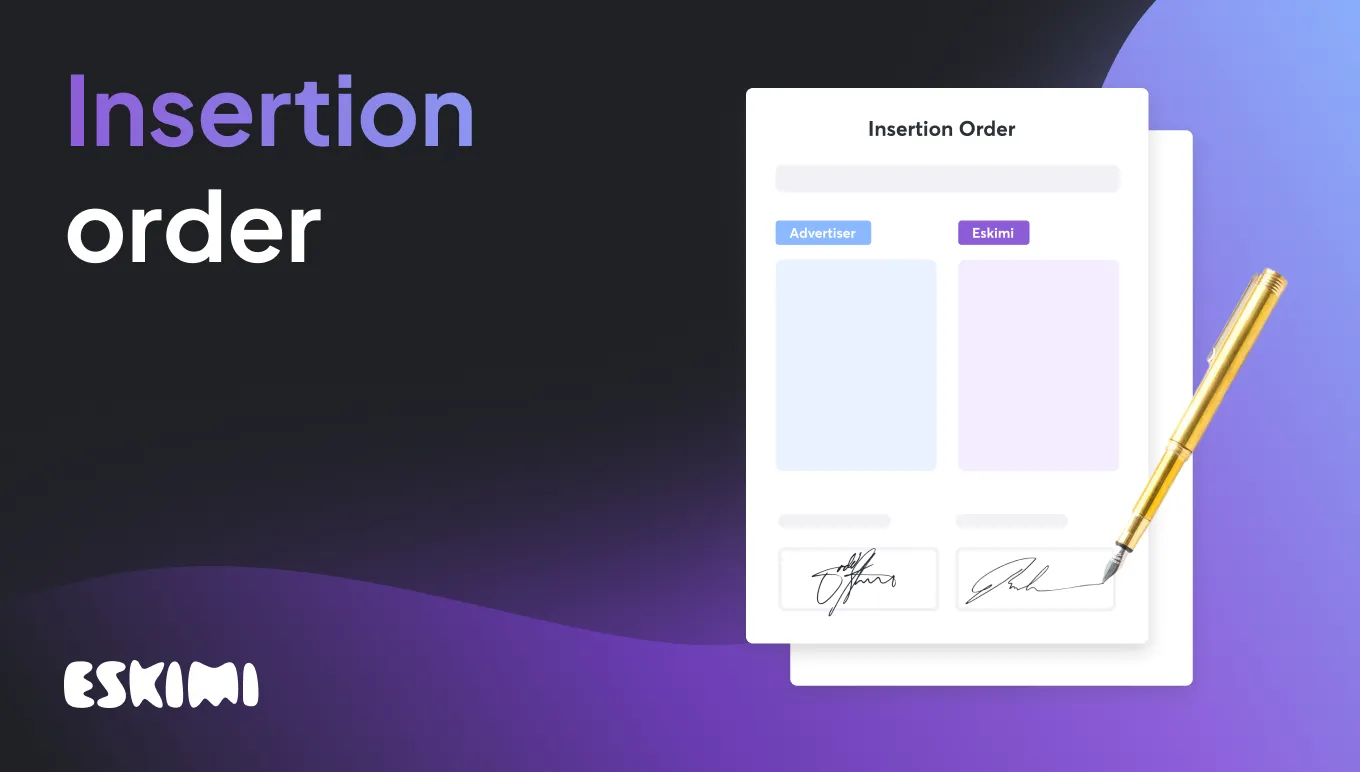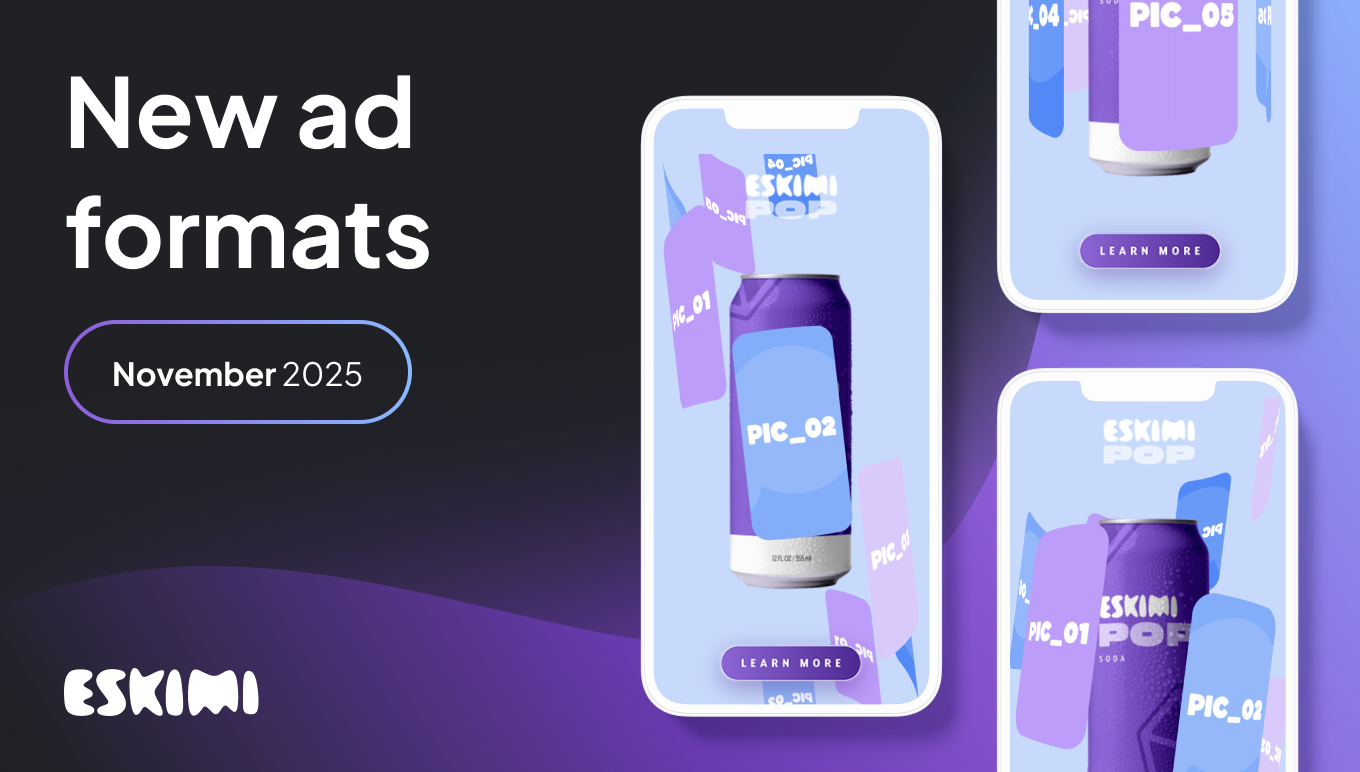What is an Insertion Order (IO)? Benefits, Tips & Template

Paperwork can often be a daunting task. Even in such a dynamic and creativity-filled industry like advertising, paperwork plays a crucial role in smooth campaign execution.
The nature of this industry is probably what makes official documents so important.
When there’s room for individual perceptions, opinions, and tastes, running an advertising campaign can quickly become very chaotic.
That’s when you can go back and look at everything you agreed on before starting it and avoid misunderstandings. Of course, only if you’ve signed an Insertion Order.
In this post, we’ll explain:
- What is an Insertion Order (IO)?
- Why it’s a must in any advertising deal?
- How it differs from a Purchase Order and Invoice
- And provide some tips on getting an IO right
Insertion Order definition
What is an insertion order?
Insertion Order is a document usually signed by the advertiser and the publisher (or advertiser and ad service provider) that contains the details of an advertising campaign. By signing an IO, both sides agree to proceed with the deal.
Put simply, it’s a legal document that states how a specific advertising campaign should be carried out.
What to include in an Insertion Order?
If you analyzed several different Insertion Orders, you’d have noticed that none of them are the same.
There is no single template for Insertion Orders, but there are recommendations on what to include to minimize the possibility of misunderstandings in the future.
Typically, an IO provides the following:
- Publisher's/ad service provider’s information – name, address, contact information.
- Client account name and IO number.
- Advertiser’s information – company name, contact person name and email, company address, country.
- Service details – channel/service name, the country where the ads will be shown, period of the campaign (start and end dates), campaign type, media budget, and the total cost of the ad campaign.
- Other relevant order information that describes the responsibilities of both parties.
Insertion Order Template

Who issues an Insertion Order?
Generally, there are no strict rules about who should issue an Insertion Order. It can be prepared by an advertiser, publisher, or an ad service provider/agency.
It’s more of a mutual agreement on who does this and depends on a particular situation.
Note: In Eskimi, the Insertion Order is always issued by the Ad Operations team once both sides agree on campaign details. After receiving a signed copy from the client, the team can start preparing and launching the ad campaign.
Is an Insertion Order legally binding?
Yes, an Insertion Order is a legally binding agreement, and any changes to it must be written down and signed by both parties.
IO is a guarantee that by confirming the final details of the order, both the client and the service provider understand and verify the campaign rules and details.
Insertion Order vs. Purchase Order vs. Invoice: key differences
It’s not that difficult to confuse IO, Purchase Order, and Invoice with one another, and it seems that many people do.
Let’s put the three of them side-by-side to learn the differences.

Purpose
Figuring out the purpose of the Insertion Order, Purchase Order, and Invoice helps to distinguish them from one another.
Insertion Order is very similar to the Purchase Order – one could even say they are the same thing.
However, the main difference between an IO and PO is that an Insertion Order is used primarily in the advertising industry, while a Purchase Order is widely used to agree on any other deal between a buyer and a seller in different sectors. Yet, they both define what has to be done to complete the order.
Invoice, on the other hand, serves the same purpose everywhere. It’s a document that sellers issue to buyers, regardless of the industry they operate in, to record the fact of purchase and demonstrate the client’s obligation to pay for the services provided/products sold.
Who issues what?
As already mentioned above, an Insertion Order can be issued by any of the parties – publishers, advertisers, or ad service providers/agencies – depending on a mutual agreement.
It’s a bit different with Purchase Orders and Invoices.
Purchase Orders are always issued by the buyer, who wants to make sure they get exactly what they ordered, while Invoices are issued by the seller, who wants to make sure that the buyer pays them.
When?
Finally, one of the key differences is when these documents are issued.
Both Insertion and Purchase Orders are issued before the order is completed, giving directions on how to proceed. Only when both sides sign them, the order can be completed.
Since an Invoice states the fact of the completed order and provides the buyer with details for paying, it is always issued after the campaign is over or products/services are sold.
Why do you need an Insertion Order in advertising?
An Insertion Order is a must-have document that ensures that advertisers and publishers/ad service providers are on the same page about the upcoming ad campaign.
Essentially, IO assures that everyone knows what they’re about to get. It includes the start and end dates of the ad campaign, budgets, ad types, channels, and other relevant details that an Insertion Order helps to put in place before the campaign even goes live.
Therefore, an IO enables advertisers to choose the best measures for achieving set KPIs and better plan their budgets, while publishers and/or service providers can better manage their cash flow and use this information to optimize the campaign for the best results.
Insertion Order benefits
Provides room for finding the best solution
Before signing an Insertion Order, both sides can list their wants, needs, and expectations for the ad campaign.
This way, advertisers can get assistance on choosing solutions that can work better based on the service provider's previous experience, agree on something new to try, and even control where their ads are placed.
Provides assurance
IO helps everyone to be more in control. It allows both sides to agree on the campaign parameters in advance, leaving no room for assumptions and clearly stating who gets what, when, and for how much.
Reduces the risk of misunderstandings
Because of the reasons above, signing an Insertion Order can help avoid misunderstandings between the advertiser and service provider during and after the campaign. If any questions arise, they can just go back and check what was agreed on, avoiding unpleasant situations.
Gives the green light for the ad launch
Insertion Order helps everyone get on the same page. Since the campaign’s details are clear and agreed on, signing an Insertion Order opens all doors for the campaign launch with a peace of mind.
Prevents ad fraud
It is suggested that the annual cost of ad fraud will grow to $100 billion in 2023 (compared to $35 billion in 2018). Sitting with publishers or ad service providers can help advertisers minimize the risk of wasting ad budgets by agreeing on the campaign details beforehand and bringing a sense of security.
Tips on preparing an Insertion Order
1. Have a clear idea of what you want
Stating exactly what you want to achieve with a particular ad campaign is one of the key things when preparing an Insertion Order.
Ideally, you should have this figured out before coming to an agency or ad service provider (or at least know the direction you want to move towards). By clearly defining your goals, you can reduce the chances of possible miscommunication and significantly shorten the discussion.
Besides, a clear vision can also help service providers to offer you better solutions and deals, which can lead to more successful campaign execution.
2. Make sure an IO includes all the necessary details
Since an Insertion Order is basically your documented ad campaign, make sure to go through all the essential details before signing it. Missing anything can impact the end result.
Check if it includes information about the channel or service name (e.g., DSP, Youtube, etc.), your campaign's start and end dates, ad campaign type, all the necessary contact details, and media budget.
This is essential for both sides to prevent possible conflict in the future.
3. Keep it simple
Insertion Order was created to make the agreement and the whole process smoother, so there’s no need to overcomplicate it.
Make sure that the Insertion Order you’re about to sign is as straightforward as possible. If you read it and find something confusing or unclear, that’s your sign to revisit it.
Clear it up before the beginning of the campaign so that everyone can get on the same page before your ads are launched.
4. Document every single change
Although signing an Insertion Order is the final step of the deal, it’s not like you carve this information in stone.
When necessary, an IO can be updated and, actually, must be updated if you happen to agree on any changes to your original Insertion Order.
Once both sides confirm, a new IO is created and must be signed by everyone involved.
5. Get it verified by both parties
It might sound obvious, but it happens – sometimes, Insertion Orders get signed by only one party.
Often, this particular situation brings more challenges for service providers as advertisers tend to skip this step of the deal.
However, signing an IO is A MUST for both sides and should be done as soon as all the campaign details are clear.
Note: In Eskimi, you will not be able to launch an ad campaign without signing an Insertion Order first.
Conclusion
As complicated as it may sound, Insertion Order is actually something that makes it all easier.
Getting everyone on the same page can significantly improve the advertising process and even kickstart long-term partnerships between advertisers, publishers, and/or advertising service providers.
Signing an Insertion Order assures both parties are happy about the agreed-upon details and are ready to hit their goals.
If you’re looking for effective and efficient ways of hitting yours, reach out to the Eskimi team or book a demo to get started.
Level Up Your Advertising with Eskimi
- Reach 96% of Open Web
- 2,500+ Targeting Options
- 100% Managed or Self-Service
- In-House Creative Studio Team
- Display, Video, In-Game & CTV
- #1 Rated DSP on G2




.png)